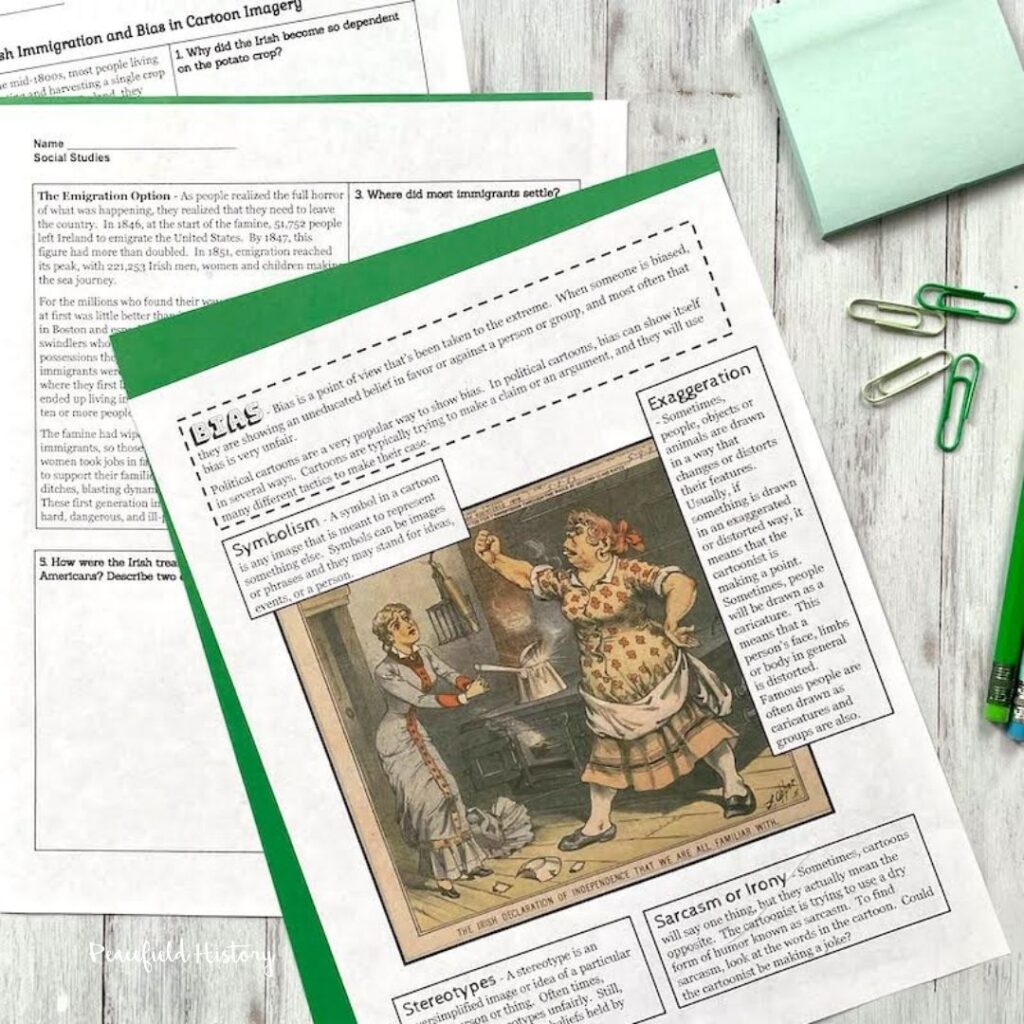
(This post contains an affiliate link.)
Every year, I have the chance to share a little bit of Irish history with my students. It’s a simple little lesson in many ways, but it always stands out as one of my favorite moments of the year.
The lesson I created came about after I read How the Irish Became White. Admittedly, I read this book many years ago, but I found the gradual process by which Irish immigrants assimilated into the “white race” fascinating. The details stuck in my brain and when I knew I would be teaching the topic of Irish History, I also knew that I also wanted to address this issue with students. The fact that supposedly rigid racial lines are actually every changing is so clearly articulated with this topic.
When Teaching About Sticky Topics – Look to the Primary Sources
Whenever I broach the subject of race with students, I look to the primary sources to tell the story. I find that students can pick out details and nuance much better by looking at sources than by any explanation from me. I specifically enjoy lessons that examine the complexity of race and the ways in which the categories have changed over the centuries.
The Actual Lesson
First, I start the lesson with a little historical background reading. Students (begin by reading about the Irish famine) and the events that caused immigration. Many of my students are descendants of Irish immigrants so they typically pepper me with questions. After we discuss the reading, I have the students examine a cartoon titled, “The Irish Declaration of Independence We Are All Familiar With.” This is one of the first times that we discuss political cartoons in class. Political cartoons did exist earlier, but many of the examples are a bit obtuse for seventh graders to decipher. This cartoon is a fantastic introduction into the way political cartoons (and the cartoonists) use imagery to make a point.

As this cartoon is from the latter half of the 19th century, it relies more on visual elements. There are two women in contrast. The first is demure, slim, and feminine. The second is much bolder in her appearance. With bright orange hair and a shamrock dress, she represents many of the stereotypes that existed regarding the Irish during that time. This cartoon is perfect for breaking down how the common traits of political cartoons – stereotypes, sarcasm, symbolism, or exaggeration – might be combined together by the cartoonist to send a message.
And truly, the message of this cartoon is quite discriminatory. The Irish woman is not cast in a positive light. She looks violent and masculine (as the cartoonist is also making a sexist statement). Beyond that, the cartoonists also drew the woman as though she was a bit primitive or animalistic. As a class, we spend a good 15 minutes just picking apart every detail. Students then look at a few more cartoons and as an exit ticket they practice the same task on their own.
Why I Love Teaching This Lesson
This lesson really causes my students to pause and think about race without making the topic overt. If I were to show them a cartoon with more familiar, modern stereotypes, confirmation bias might cause the students to accept the cartoon at face value. However, with this cartoon, the stereotypes are a complete surprise. Nothing they see in this Irish woman represents anything they know about the Irish. Besides the shamrocks and the shock of red hair, this stereotype is new – and clearly untrue.
When I mention the fact that stereotypes were often used against the Irish in that time, that the Irish faced discrimination as new immigrants, and that they weren’t considered to be “white,” my students are completely surprised. As I often teach with students of Irish descent, they are flummoxed by the idea that their ancestors weren’t considered part of the “white race” at one point in history. How could that be? As one student noted, “I burn after 15 minutes in the sun!” Then I point out – if Irish people, Italians, and sometimes Germans were not considered to be members of the “white race,” maybe race didn’t have much to do with skin color.
A Little Extra Detail
To end the lesson, I introduce students to a little bit of the Gaelic language. I talk about how the language was suppressed in Ireland for many years and how the Irish government is trying to bring it back. Then, we practice saying some words. (Youtube is really helpful here – I really like this video).
These are the lessons that I enjoy the most. It’s not some big sweeping 5-week project. It’s just a one day lesson. Despite the smallness of the experience, it gets my students to think about a topic from a new approach. Students really do appreciate a lesson that causes them to rethink something that they thought they understood, and I love guiding them in their thinking.
You can check out the lesson in my shop. It’s located here – Irish Famine and Immigration – Seeing Bias Through Imagery
Every classroom is different and this specific lesson might not work with your students. Regardless, thinking about how you can surprise students with little details from history is just another way to engage students in THINKING about history.

2 Responses
What a great idea!
Thank you, you always have wonderful ideas that help my students learn. I so appreciate it.